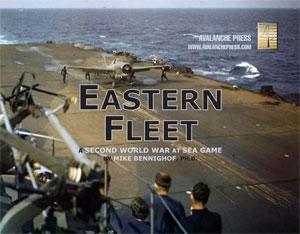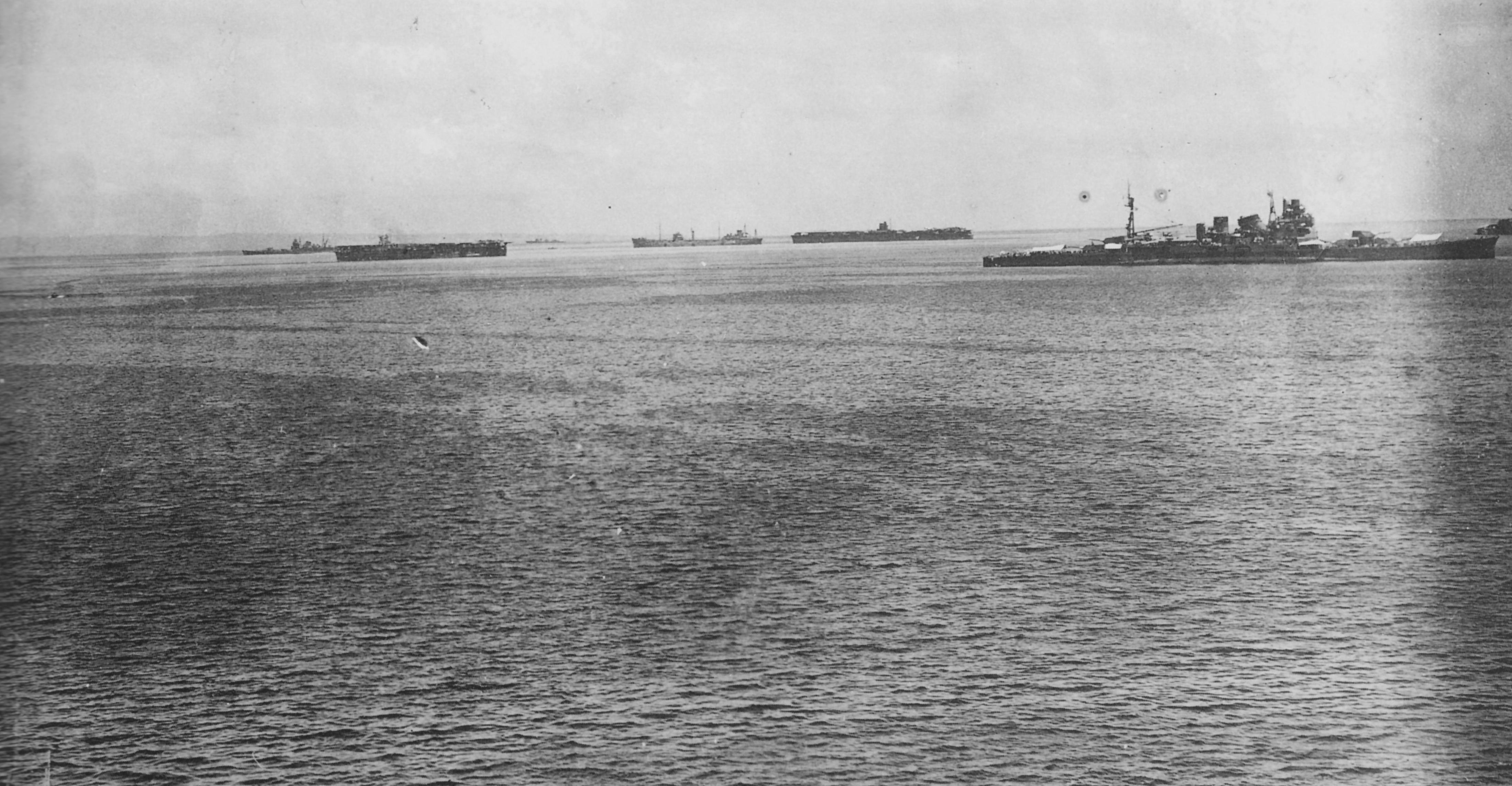| Eastern Fleet:
The Indian Ocean Adventure
By Mike Bennighof, Ph.D.
October 2021
 Japan’s move into the Indian Ocean did not come as the result of long-standing plans of conquest. Having achieved their initial goal (the destruction of much of the U.S. Pacific Fleet at Pearl Harbor) and begun the occupation of resource-rich British and Dutch colonies in South-East Asia, the Combined Fleet’s leadership floundered while trying to decide upon their next step. Japan’s move into the Indian Ocean did not come as the result of long-standing plans of conquest. Having achieved their initial goal (the destruction of much of the U.S. Pacific Fleet at Pearl Harbor) and begun the occupation of resource-rich British and Dutch colonies in South-East Asia, the Combined Fleet’s leadership floundered while trying to decide upon their next step.
The obvious course would be to follow up the attack on Pearl Harbor with a full-scale invasion of Hawaii. Those dreams fell apart under hard realities of planning such an operation: the carriers of the First Air Fleet could not hope to suppress the hundreds of aircraft the Americans had based on the island of Oahu. Oahu itself would be difficult to capture, but even if the Imperial Army managed to defeat the garrison, they would then be at the end of a very long supply line. The civilian population, which included many Japanese, would also have to be fed.
Even so, Combined Fleet commander Isoroku Yamamoto and many of his staff wanted to invade Hawaii. The Imperial Army, however, would not provide troops for the operation and similarly quashed the idea of invading Australia, or at least occupying part of its northern coast. Invasions of Fiji and Samoa to cut communications between Australia and the United States would require fewer soldiers, but the garrisons again would be at the end of a very long supply line that the Army doubted its sister service could maintain.

The First Air Fleet in Staring Bay, Celebes, February 1942.
As their frustration increased, Navy planners looked to the West. An invasion of Ceylon, the large island off the southern tip of India, might provide bases for further operations in the Indian Ocean and help trigger anti-British uprisings in India.
Having finally settled on an idea, the Combined Fleet staff met aboard the new flagship Yamato in late February 1942 for a series of wargames. “The idea of the operation in the Indian Ocean,” Rear Admiral Matome Ugaki, the Combined Fleet’s chief of staff, wrote in his diary, “was not good.” British air power based on Ceylon would be a serious obstacle, the games revealed, and the Japanese would have trouble locating the enemy’s Eastern Fleet unless it were caught still at its bases.
The Imperial Army did not immediately object to the operation, but faced with the commitment of five or six divisions for garrison duty, beyond the additional forces needed to conquer the island, the generals eventually vetoed Army participation. While Andrew Boyd (in The Royal Navy in Eastern Waters) asserts that, “despite the Japanese army claims, sufficient Japanese land forces to attack Ceylon were available at this time,” this does not seem to be actually true. The Japanese Army appears to have considered that two divisions that had fought in the Dutch East Indies (38th and 48th) might soon be made available. Additionally, the Imperial Guards and 5th Infantry Divisions might have been deployed after the fall of Singapore in February. But at the time plans were made, all four divisions were still engaged in combat.

A Bristol Blenheim bomber takes off from Colombo, Ceylon. 1942.
On top of that, the Imperial Navy simply did not have the lift capacity to move four divisions at once. Even that force would be unlikely to overcome the Ceylon garrison, which included at least three divisions - 20th and 34th Indian and 6th Australian, plus one East African brigade and another of locally-raised troops. The largest Japanese convoy operation of World War II took place in March 1942, as 32 transports moved a single division plus supporting units from Singapore to Rangoon.
Boyd also lays out dire consequences for the Allied war effort should the Japanese capture Ceylon, interdict Allied sea routes across the Indian Ocean and link up with the Germans somewhere in the Middle East. Without the oil resources of Abadan in Iran, the Allies would have to move fuel from the United States on the other side of the globe in the midst of a grave tanker shortage. Shipments of aircraft, vehicles and weapons across Iran to the Soviet Union would likewise be interrupted.
Though these possibilities weighed heavily on the minds of Allied leaders and staff officers, they need not have been so concerned. As Jonathan Parshall and Anthony Tully make clear in Shattered Sword, the Combined Fleet’s staff had only a bare glimmering of such strategic conceptions. They gave little thought to how they would move the invasion force across the Bay of Bengal, and none to how they would supply it once the troops landed. Nor did they expend too much thought on what use they might make of their newly-captured bases on Ceylon.
The Imperial Army understood the fantasy world inhabited by their naval counterparts, and also had learned from hard experience how inter-service rivalries often played out. The generals knew that Yamamoto actually wanted to invade Hawaii, and should the Army admit that it could spare the four divisions for Ceylon the troops might soon find themselves bound for Oahu instead, the bait-and-switch being just as common in Japanese military politics as it is in modern-day office politics.
Balked at achieving their consolation prize of invading Ceylon, the Combined Fleet staff pressed ahead with plans for a raid into the Indian Ocean by the First Air Fleet’s six heavy carriers. Rear Admiral Ryunosuke Kusaka, the carrier force’s chief of staff, urged that instead of pursuing a new operation the First Air Fleet remain in Japanese waters training new pilots and preparing to counter American moves against the Japanese defense perimeter. That plea would be ignored; the carriers would remain on the offensive. Once unsheathed, the sword must be used.

Carrier Akagi leaves Staring Bay for the Indian Ocean, 26 March 1942.
Kusaka’s boss, Chuichi Nagumo, was tasked with seeking out and destroying the British Eastern Fleet, in particular its aircraft carriers. This would have little impact on the Japanese strategic position, since the Ceylon invasion had been taken off the table and the Japanese were not overly concerned about British attacks on the just-occupied Dutch East Indies. They did have a fairly accurate assessment of British naval strength in the Indian Ocean, correctly projecting the imminent arrival of two fleet carriers to join the ancient light carrier and quartet of elderly battleships.
Five of Nagumo’s carriers left Staring Bay on the island of Celebes on 26 March 1942 (one had run aground and needed repairs in Japan), along with four fast battleships and escorting cruisers and destroyers. They set out for battle for the most mundane of reasons: because the Imperial Navy’s high command quite literally could not think of anything better for them to do.
Click here to order Eastern Fleet!
Sign up for our newsletter right here. Your info will never be sold or transferred; we'll just use it to update you on new games and new offers.
Mike Bennighof is president of Avalanche Press and holds a doctorate in history from Emory University. A Fulbright Scholar and NASA Journalist in Space finalist, he has published an unknowable number of books, games and articles on historical subjects.
He lives in Birmingham, Alabama with his wife, three children and his dog, Leopold.
Want to keep Daily Content free of third-party ads? You can send us some love (and cash) through this link right here.
|
